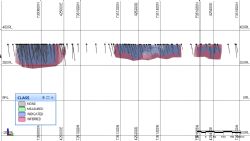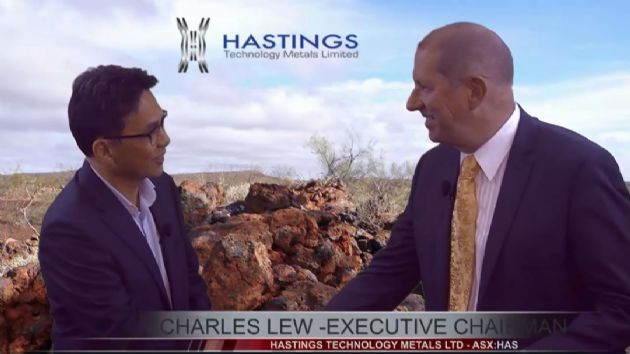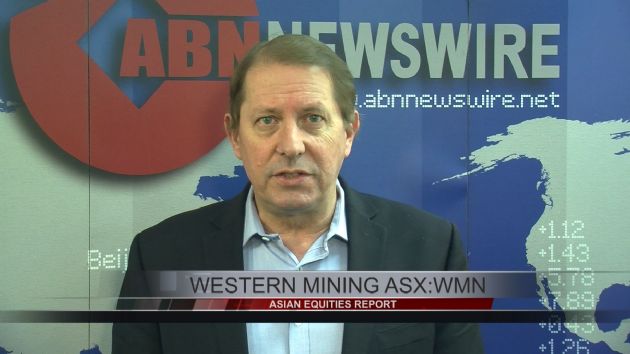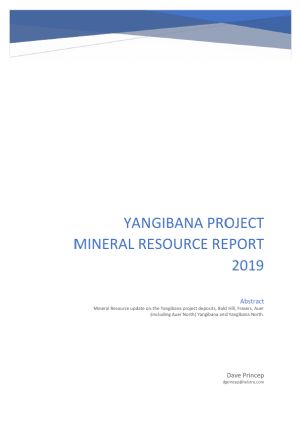
Increase in Measured and Indicated Resources at Yangibana Project
Sydney, Nov 28, 2018 AEST (ABN Newswire) - The Directors of Hastings Technology Metals Limited ( ASX:HAS) are pleased to announce a 6.7% increase in Measured plus Indicated Resources at the Yangibana Project compared to the most recent JORC Mineral Resource estimate in November 2017 (ASX release titled "Final 2017 JORC Resource Update including Auer and Auer North Results" 22nd November 2017). Measured plus Indicated Resources now stand at 13.38 million tonnes within a total resource of 21.67 million tonnes. The total resource now hosts more than 80,000 tonnes of neodymium and praseodymium oxide, the Company's main economic driver.
ASX:HAS) are pleased to announce a 6.7% increase in Measured plus Indicated Resources at the Yangibana Project compared to the most recent JORC Mineral Resource estimate in November 2017 (ASX release titled "Final 2017 JORC Resource Update including Auer and Auer North Results" 22nd November 2017). Measured plus Indicated Resources now stand at 13.38 million tonnes within a total resource of 21.67 million tonnes. The total resource now hosts more than 80,000 tonnes of neodymium and praseodymium oxide, the Company's main economic driver.
- Measured plus Indicated Resources increased by 6.7% to 13.38 million tonnes
- Total Resources increased to 21.67 million tonnes
- Contained neodymium and praseodymium oxide exceeds 80,000 tonnes in total resources
- Programmes in place for next drilling phase in 2019
JORC Mineral Resources
An updated JORC Mineral Resource estimation has been completed by independent consultant Lynn Widenbar and Associates incorporating the recent drilling results from Bald Hill, Fraser's, Auer and Auer North deposits.
The bulk of the near surface mineralisation (at least to 100m vertical depth) throughout the Yangibana Project is hosted by iron oxides and hydroxides termed ironstone, being the alteration products of the primary hosts - ferrocarbonatite and phoscorite intrusive veins. The main rare earths-bearing mineral is monazite which has locally undergone alteration at shallow depths (to 25m depth) to its hydrous equivalent rhabdophane and to rare earths-bearing Al-phosphates such as florencite.
The deposits occur as narrow but strike extensive veins that have a range of dips from almost horizontal (10-20o) to sub-vertical. The Fraser's deposit has the most extreme range from 5o in portions towards its northeastern end to 65o at its southwestern end. Average true thickness varies from 2.2m to 3.5m throughout the Yangibana deposits although locally true thicknesses in excess of 20m occur.
Hastings has completed eight drilling programmes comprising both reverse circulation (RC) and diamond drilling totalling more than 1,500 holes for 80,000m. Of these 127 holes for 7,485m are diamond holes.
Holes were initially drilled at 50m spacings along strike and down dip. Infill drilling in areas with resource potential has been undertaken at 37.5m spacing, although this has been constrained by access in places and drill spacing is often less than that figure.
RC holes have been drilled using a nominal 51/4 inch diameter face-sampling bit. Samples have been collected through a built-in cyclone with a triple-tier riffle-splitting system providing a large sample of approximately 25kg and a sub-sample of 2-4kg of which selected samples were sent for analysis, from each metre drilled. Field duplicates, blanks and Reference Standards were inserted at a rate of approximately 1 in 20.
Diamond core has been drilled at HQ size. The core is logged and prospective zones are sawn into half and one half is then quartered with one quarter sent for analysis. Assayed intervals are based on geology with a minimum length of 0.2m.
Samples were routinely sent to Genalysis in Perth for analysis using techniques considered appropriate for the style of mineralisation. Samples were analysed for the range of rare earths, rare metals (Nb, Ta, Zr), thorium and uranium and a range of common rock-forming elements (Al, Ca, Fe, Mg, Mn, P, S, Si, Sr). Duplicate samples have been sent to SGS Laboratories for cross-checking.
Most drillholes were vertical, subject to access availability, with holes into the steeper mineralised zones (Auer, Auer North, the southeastern portion of Fraser's) being at -60o or -70o. Internal surveys were carried out at 30m intervals downhole by the drilling contractors using a Reflex electronic single-shot camera within a stainless-steel drill rod.
Collar surveys were carried out by the Company using a Trimble RTX R1 GNSS receiver, with accuracies of approximately 50cm. The high-resolution DTM commissioned by the Company has been used as the topographic control for all drillholes. A Relative Level (RL) was assigned to each drillhole collar based on the high-resolution DTM using Mapinfo Discover 3D.
Once assay data were returned, the elemental values were converted to oxides using standard factors. Interpretations were carried out initially on sections using logged geology and then a nominal 0.2%Nd2O3+Pr6O11 cut-off to define the mineralisation of interest. With current commodity prices of US$59/kg for praseodymium oxide and US$48/kg for neodymium oxide (BAIINFO Rare Earth Weekly, Nov 15 2018) and predicted to increase over the coming years (Adamas Intelligence, July 2018), this cut-off is considered reasonable for both downhole intersections and resource estimation.
This cut-off correlates extremely well with the visual estimation based on geology. At a later stage, flitch plans and footwall and hangingwall contour plans were prepared to confirm interpretation. There is, therefore, a high confidence in the geological interpretation.
Following validation of the database all information was imported into Micromine Mining software where validation routines were run to check validity of all data.
The Micromine models were sent to the resource consultant (Lynn Widenbar) and statistical analysis and variography was undertaken to define parameters for an Ordinary Kriging estimation. Estimations were carried out using Micromine software (MM 2016 Sp5) with Nd2O3 and Pr6O11 used to define kriging parameters. Estimations were carried out for all assayed variables. Each deposit was initially drilled at 50m intervals along strike and down dip, testing the areas with better outcrop and their extensions. Infill drilling was then undertaken to close the drill-spacing to around 37.5m as suggested by the variography. In certain areas drill spacing is highly variable due to access considerations. Despite this variable spacing, in general the resource blocks are 12.5m along strike by 10m down dip by 2.5m across strike. The block models have been validated by several methods.
Bulk density has been measured by either the Company or at independent laboratories on core from each of the main deposits. Samples from each of the oxidised, partially oxidised, and fresh mineralisation have been tested with results feeding into the resource estimations based on weathering surfaces as defined by the Company.
Based on previous and ongoing mining studies, a 0.5m dilution skin has been added to both the footwall and hangingwall of the interpreted mineralisation. This dilution material is independently interpolated and the results are subsequently added to the mineralised domain to provide a diluted resource as reported.
The mineral resources have been classified in the Measured, Indicated and Inferred categories, in accordance with the 2012 Australasian Code for Reporting of Mineral Resources and Ore Reserves (JORC) by the Competent Person. A range of criteria has been considered in determining the classification including geological and grade continuity, data quality, drill hole spacing, and modelling technique and kriging output parameters.
As a general rule, the following spacings characterise the resource classification.
- Infill drilling between 20m by 20m and 35m by 35m - Measured
- Drill spacing 50m by 50m - Indicated
- Drill spacing 100m by 50m to 100m by 100m - Inferred
The shallow nature of the mineralisation tested by Hastings to date (almost all within 120m of surface) and the high potential value of the mineralisation at the selected (and geologically sensible) cut-off grade used supports the classification of the resources.
Metallurgical testwork has established a viable processing route for the majority of the deposits tested to date. Variability testwork is continuing to confirm this.
The total resources as at October 2018 are as shown in Table 1. Note that in all resource tables rounding errors may appear. The resources are based on a, with a minimum width of 1.0m. 0.5m of dilution at grade from both the hangingwall and the footwall is incorporated into the estimation.
These figures represent a modest increase in total tonnes compared to the previous estimate from 20,996,000 (+3.2%), but a significant increase in Measured plus Indicated Resources (+6.7%), particularly in the Measured category that has increased by 21.1%.
Resources from the deposits that are planned for early development - Bald Hill and Fraser's - are shown in Tables 2 and 3. Both deposits are within granted Mining Leases held 100% by Hastings.
Following the recent drilling at Auer and Auer North (ASX Release titled "Successful Infill and Extension Drilling at Auer, Auer North" 5th October2018) , the main increases in total resources are at these deposits as shown in Tables 4 and 5. Both deposits are within Exploration Licences held 100% by Hastings and the Company will make application for a Mining Lease in the near future.
Longitudinal sections of Auer and Auer North showing accumulation (metre % Nd2O3+Pr6O11) are shown in Figures 1 and 3 showing good potential for additional resources particularly at depth along the length of Auer and at Auer North Zone 1. Figures 2 and 4 show the resource categorisation for the two deposits.
JORC Mineral Resources for Yangibana, Yangibana West, and Yangibana North are shown in Tables 6, 7 and 8 respectively.
Of the total resources at Yangibana, 1,900,000 tonnes are within Mining Lease 09/165 held 100% by Hastings and 269,000 tonnes are within Mining Lease 09/163 in which Hastings holds a 70% interest.
Yangibana West lies within Mining Lease 09/160 held 100% by Hastings. The mineralisation is part of a continuous deposits that extends into Mining Lease 09/159, in which Hastings holds a 70% interest, as Yangibana North.
JORC Mineral Resources at Simon's Find are shown in Table 9. These resources are located within Mining Lease 09/158 and Exploration Licence 09/1943, both held 100% by Hastings. Additional drilling and metallurgical testwork will be undertaken prior to the application for a second Mining Lease.
JORC Inferred Mineral Resources at Gossan, Lion's Ear, Hook and Kane's Gossan are shown in Table 10. These deposits are all within Mining Lease 09/159 in which Hastings holds a 70% interest.
A proposed drilling programme for 2019 has been established and will commence with holes testing the large aeromagnetic anomaly reported recently (ASX Release titled "Major Aeromagnetic Target Identified at Yangibana" 8th August 2018).
TERMINOLOGY USED IN THIS REPORT
Total Rare Earths Oxides, TREO, is the sum of the oxides of the light rare earth elements lanthanum (La), cerium (Ce), praseodymium (Pr), neodymium (Nd), and samarium (Sm) and the heavy rare earth elements europium (Eu), gadolinium (Gd), terbium (Tb), dysprosium (Dy), holmium (Ho), erbium (Er), thulium (Tm), ytterbium (Yb), lutetium (Lu), and yttrium (Y).
To view tables and figures, please visit:
http://abnnewswire.net/lnk/049657SQ
About Hastings Technology Metals Ltd
 Hastings Technology Metals Ltd (ASX:HAS) (FRA:5AM) is advancing its Yangibana Rare Earths Project in the Upper Gascoyne Region of Western Australia towards production. The proposed beneficiation and hydro metallurgy processing plant will treat rare earths deposits, predominantly monazite, hosting high neodymium and praseodymium contents to produce a mixed rare earths carbonate that will be further refined into individual rare earth oxides at processing plants overseas.
Hastings Technology Metals Ltd (ASX:HAS) (FRA:5AM) is advancing its Yangibana Rare Earths Project in the Upper Gascoyne Region of Western Australia towards production. The proposed beneficiation and hydro metallurgy processing plant will treat rare earths deposits, predominantly monazite, hosting high neodymium and praseodymium contents to produce a mixed rare earths carbonate that will be further refined into individual rare earth oxides at processing plants overseas.
Neodymium and praseodymium are vital components in the manufacture of permanent magnets which is used in a wide and expanding range of advanced and high-tech products including electric vehicles, wind turbines, robotics, medical applications and others. Hastings aims to become the next significant producer of neodymium and praseodymium outside of China.
Hastings holds 100% interest in the most significant deposits within the overall project, and 70% interest in additional deposits that will be developed at a later date, all held under Mining Leases. Numerous prospects have been identified warranting detailed exploration to further extend the life of the project.
Brockman Project
The Brockman deposit, near Halls Creek in Western Australia, contains JORC Indicated and Inferred Mineral Resources, estimated using the guidelines of JORC Code (2012 Edition).
The Company is also progressing a Mining Lease application over the Brockman Rare Earths and Rare Metals Project.
Hastings aims to capitalise on the strong demand for critical rare earths created by the expanding demand for new technology products.
| ||
|













